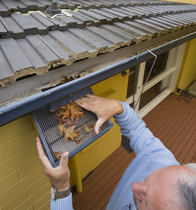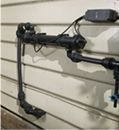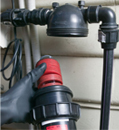Tank filtration

Potential for contamination
The greatest risk of contamination comes not from the rainwater tank but from the roof and gutters along which rainwater travels. Between downpours, the average roof collects numerous contaminants, including bird and other animal droppings, pollution from vehicles, stoves and heaters, as well as roof coatings and sealants. All of these wash into downpipes with the first flow of rainwater.
Prevention
Gutter guards and gutter mesh or special gutters with filters are a recommended first step in preventing leaves and debris entering the guttering and tank. Leaves can block guttering causing the rainwater to overflow rather than go into the tank. Blockages can also cause water to pool in the gutter, providing a habitat for mosquitoes. Leaf guards can either be fitted to the full length of house gutters or they can be a separate trap fitted to the downpipes, before the inlet of the tank (see below on rainheads). All inlets and outlets around the tank system should have insect-proof screens to stop mosquitoes.
Rainheads have a course mesh filter, which stops leaves from entering downpipes, and a finer mesh filter that prevents small fragments and mosquitoes entering. If the tanks are above ground then the rainheads need to be placed above the tank inlet height, generally requiring a ladder to clean them out. This can be slightly awkward as depending on your surrounding trees, rainheads may need to be cleaned regularly or in some cases every time it rains. If your tank is underground you can place the rainheads at a manageable level for easy and regular cleaning without ladders. Removal First-flush devices divert the initial flow of water away from the tank to prevent contaminants entering the rainwater tank. This water can be diverted to stormwater drainage, a garden area, raingarden or into a smaller holding tank for use on the garden. First-flush systems will help to prevent the build-up of sludge on the bottom of your tank, thus reducing the need for regular cleaning.
First-flush devices are an effective way of keeping tanks clean, but they divert the initial flow of water away from your tank and reduce the amount of water entering the tank. If every drop of water is important, then perhaps other filtration methods that don't divert water away from your tank are worth considering.
Water Filtration

The need to filter rainwater as it leaves the tank will depend on the quality of the water entering the tank as well as its end use. For instance, if the water is only to be used directly on the garden through a hose, then the water may not need to be filtered. However if it is to be run through a drip irrigation system, you may need to install a screen or disc filter to prevent the drip system clogging with small particles in the water.
If the water is to be used inside the home it is recommended that more comprehensive filtering systems be installed such as cartridge or UV filters.

Carbon cartridge filters are the most common and widely available form of filtration and are made from activated carbon. The cartridges are designed to remove sediment, colour and odour from the water but they do not remove microbes. The filters need to be installed in a suitable position along the waterline before the water enters the home or garden tap. This is generally on an external wall where you can access the filter, as cartridges need to be regularly changed – generally between 6 to 12 months depending on the quality of filter and water.
Ultraviolet light is a popular method for treating rainwater, particularly if you intend to drink the rainwater entering your house. UV light systems can be installed to disinfect the whole rainwater supply to the house, or can be installed on individual taps such as at the kitchen sink. They consist of a cylinder that houses the UV light tube, which is connected in-line with the pipe so that incoming water is exposed to the UV light as it flows over the tube. UV lights need to be cleaned or replaced periodically according to the manufacturer’s specifications.
Muck at the bottom of the tank
Water tanks can slowly build up a layer of sludge on the bottom. This is caused by dust and debris entering the tank, which will happen no matter how good your preventative regime may be. Depending on the run-off surface, sediments that accumulate below good quality rainwater can contain concentrations of chemicals, such as zinc or lead. However generally, as long as the sludge layer sitting on the bottom of a tank is not disturbed, it should remain separate from the "good quality" water.
When to clean out the tank
Check your tank for sludge every two to three years. If a build-up of sludge is apparent you may need to clean out your tank. If you do not have adequate access it can be cleaned out by a tank cleaning company.
First-flush system and tank strainer work well. However, we must clean out first-flush system regularly (at least every 1-2 months) as it builds up and the water can get smelly.
Don’t use gutter guards as they just make cleaning difficult. I use smoothline gutters with under- gutter outlets, then leaf eaters and first-flush diverters. There is also an inline filter.
We have a first-flush device and filter to remove colour before it comes into the house. We found that toilets and washing were yellowing. The filter dealt with that.
Input to primary tank goes through a gauze filter. Other than that, no problems. Water quality checked every two years.